Travel and Tourism Business Toolkit Report: Revenue, HR, Legislation
VerifiedAdded on 2021/02/20
|21
|5897
|48
Report
AI Summary
This report provides a detailed analysis of the Travel and Tourism Business Toolkit, focusing on revenue management, HR lifecycle, and relevant legislation. The report begins by examining the rationale and principles of revenue management, including market segmentation, demand forecasting, and overbooking control, and then explores the application of revenue management tools to maximize profit, such as capacity utilization, discount allocation, and duration control, with specific application to Thomas Cook. Furthermore, it assesses the impact of differentiated pricing strategies. The second part delves into the different stages of the HR lifecycle, performance management plans, and the importance of the HR lifecycle within the tourism sector. The report then analyzes financial statements and reporting mechanisms, including income statements, cash flow statements, and balance sheets, providing interpretations and evaluating business performance. Finally, it covers specific legislations within the travel and tourism industry, the impact of company, employment, and contract law on decision-making, and potential implications of regulations and ethical principles on business operations, culminating in a conclusion that summarizes the key findings and recommendations.
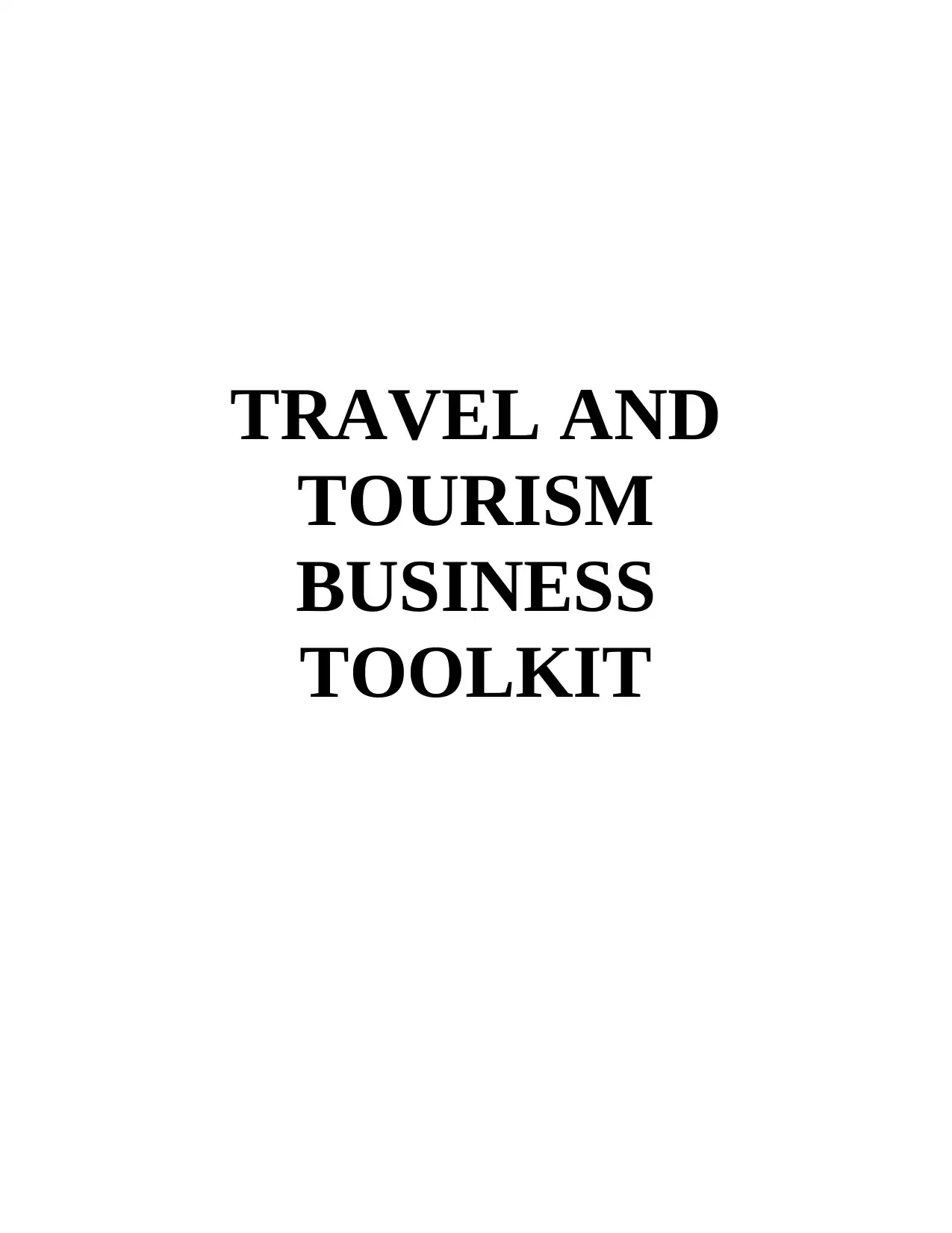
TRAVEL AND
TOURISM
BUSINESS
TOOLKIT
TOURISM
BUSINESS
TOOLKIT
Paraphrase This Document
Need a fresh take? Get an instant paraphrase of this document with our AI Paraphraser
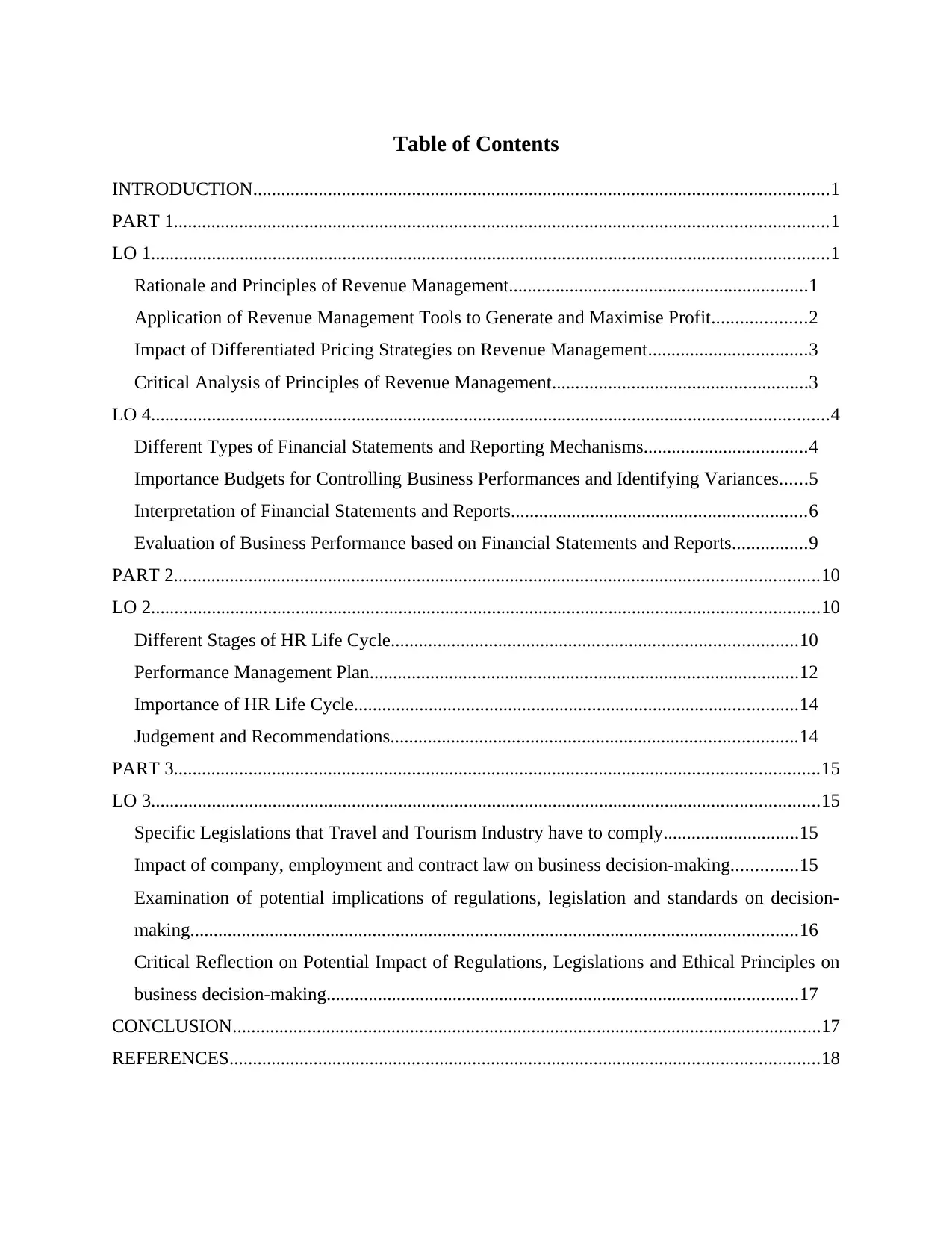
Table of Contents
INTRODUCTION...........................................................................................................................1
PART 1............................................................................................................................................1
LO 1.................................................................................................................................................1
Rationale and Principles of Revenue Management................................................................1
Application of Revenue Management Tools to Generate and Maximise Profit....................2
Impact of Differentiated Pricing Strategies on Revenue Management..................................3
Critical Analysis of Principles of Revenue Management.......................................................3
LO 4.................................................................................................................................................4
Different Types of Financial Statements and Reporting Mechanisms...................................4
Importance Budgets for Controlling Business Performances and Identifying Variances......5
Interpretation of Financial Statements and Reports...............................................................6
Evaluation of Business Performance based on Financial Statements and Reports................9
PART 2..........................................................................................................................................10
LO 2...............................................................................................................................................10
Different Stages of HR Life Cycle.......................................................................................10
Performance Management Plan............................................................................................12
Importance of HR Life Cycle...............................................................................................14
Judgement and Recommendations.......................................................................................14
PART 3..........................................................................................................................................15
LO 3...............................................................................................................................................15
Specific Legislations that Travel and Tourism Industry have to comply.............................15
Impact of company, employment and contract law on business decision-making..............15
Examination of potential implications of regulations, legislation and standards on decision-
making..................................................................................................................................16
Critical Reflection on Potential Impact of Regulations, Legislations and Ethical Principles on
business decision-making.....................................................................................................17
CONCLUSION..............................................................................................................................17
REFERENCES..............................................................................................................................18
INTRODUCTION...........................................................................................................................1
PART 1............................................................................................................................................1
LO 1.................................................................................................................................................1
Rationale and Principles of Revenue Management................................................................1
Application of Revenue Management Tools to Generate and Maximise Profit....................2
Impact of Differentiated Pricing Strategies on Revenue Management..................................3
Critical Analysis of Principles of Revenue Management.......................................................3
LO 4.................................................................................................................................................4
Different Types of Financial Statements and Reporting Mechanisms...................................4
Importance Budgets for Controlling Business Performances and Identifying Variances......5
Interpretation of Financial Statements and Reports...............................................................6
Evaluation of Business Performance based on Financial Statements and Reports................9
PART 2..........................................................................................................................................10
LO 2...............................................................................................................................................10
Different Stages of HR Life Cycle.......................................................................................10
Performance Management Plan............................................................................................12
Importance of HR Life Cycle...............................................................................................14
Judgement and Recommendations.......................................................................................14
PART 3..........................................................................................................................................15
LO 3...............................................................................................................................................15
Specific Legislations that Travel and Tourism Industry have to comply.............................15
Impact of company, employment and contract law on business decision-making..............15
Examination of potential implications of regulations, legislation and standards on decision-
making..................................................................................................................................16
Critical Reflection on Potential Impact of Regulations, Legislations and Ethical Principles on
business decision-making.....................................................................................................17
CONCLUSION..............................................................................................................................17
REFERENCES..............................................................................................................................18
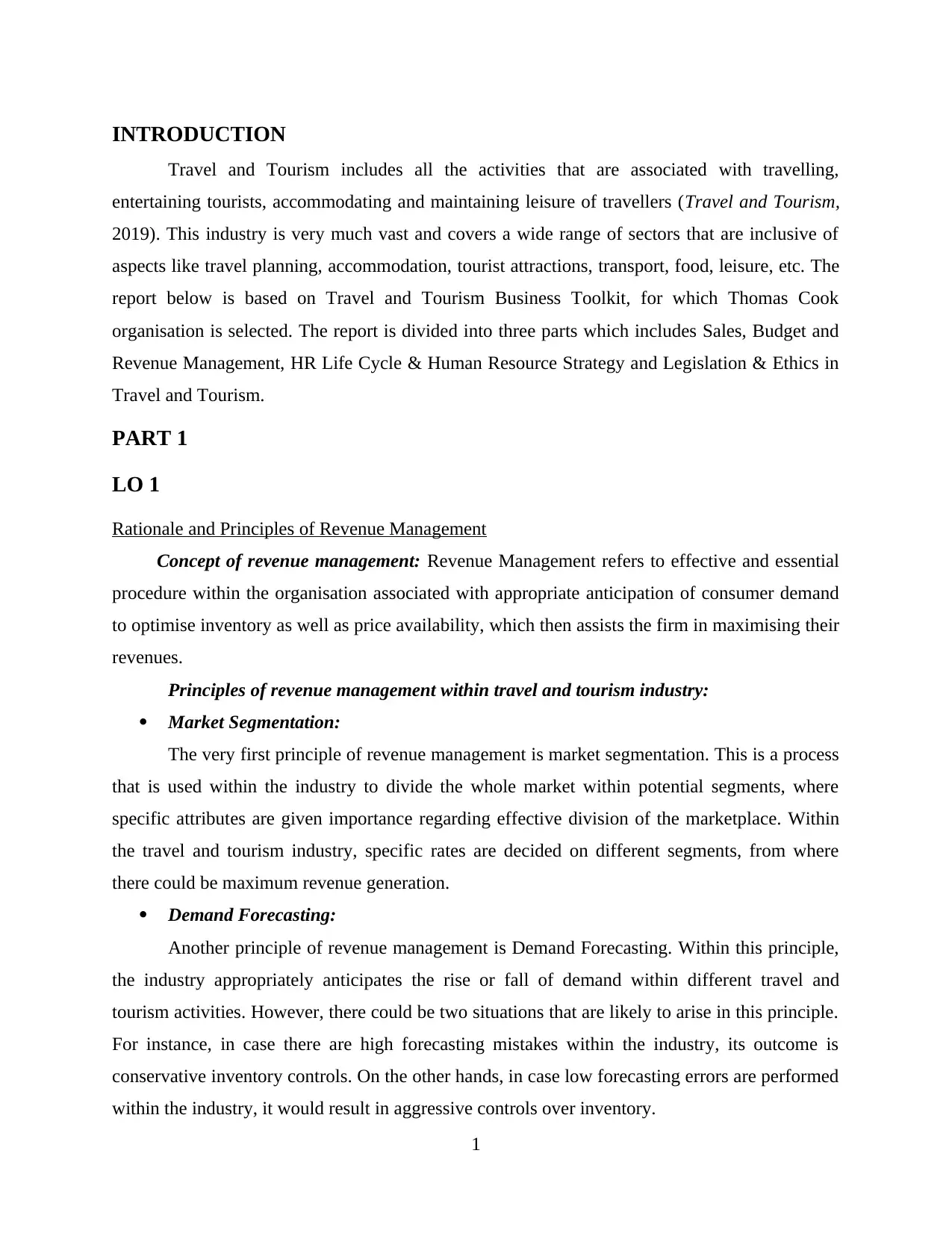
INTRODUCTION
Travel and Tourism includes all the activities that are associated with travelling,
entertaining tourists, accommodating and maintaining leisure of travellers (Travel and Tourism,
2019). This industry is very much vast and covers a wide range of sectors that are inclusive of
aspects like travel planning, accommodation, tourist attractions, transport, food, leisure, etc. The
report below is based on Travel and Tourism Business Toolkit, for which Thomas Cook
organisation is selected. The report is divided into three parts which includes Sales, Budget and
Revenue Management, HR Life Cycle & Human Resource Strategy and Legislation & Ethics in
Travel and Tourism.
PART 1
LO 1
Rationale and Principles of Revenue Management
Concept of revenue management: Revenue Management refers to effective and essential
procedure within the organisation associated with appropriate anticipation of consumer demand
to optimise inventory as well as price availability, which then assists the firm in maximising their
revenues.
Principles of revenue management within travel and tourism industry:
Market Segmentation:
The very first principle of revenue management is market segmentation. This is a process
that is used within the industry to divide the whole market within potential segments, where
specific attributes are given importance regarding effective division of the marketplace. Within
the travel and tourism industry, specific rates are decided on different segments, from where
there could be maximum revenue generation.
Demand Forecasting:
Another principle of revenue management is Demand Forecasting. Within this principle,
the industry appropriately anticipates the rise or fall of demand within different travel and
tourism activities. However, there could be two situations that are likely to arise in this principle.
For instance, in case there are high forecasting mistakes within the industry, its outcome is
conservative inventory controls. On the other hands, in case low forecasting errors are performed
within the industry, it would result in aggressive controls over inventory.
1
Travel and Tourism includes all the activities that are associated with travelling,
entertaining tourists, accommodating and maintaining leisure of travellers (Travel and Tourism,
2019). This industry is very much vast and covers a wide range of sectors that are inclusive of
aspects like travel planning, accommodation, tourist attractions, transport, food, leisure, etc. The
report below is based on Travel and Tourism Business Toolkit, for which Thomas Cook
organisation is selected. The report is divided into three parts which includes Sales, Budget and
Revenue Management, HR Life Cycle & Human Resource Strategy and Legislation & Ethics in
Travel and Tourism.
PART 1
LO 1
Rationale and Principles of Revenue Management
Concept of revenue management: Revenue Management refers to effective and essential
procedure within the organisation associated with appropriate anticipation of consumer demand
to optimise inventory as well as price availability, which then assists the firm in maximising their
revenues.
Principles of revenue management within travel and tourism industry:
Market Segmentation:
The very first principle of revenue management is market segmentation. This is a process
that is used within the industry to divide the whole market within potential segments, where
specific attributes are given importance regarding effective division of the marketplace. Within
the travel and tourism industry, specific rates are decided on different segments, from where
there could be maximum revenue generation.
Demand Forecasting:
Another principle of revenue management is Demand Forecasting. Within this principle,
the industry appropriately anticipates the rise or fall of demand within different travel and
tourism activities. However, there could be two situations that are likely to arise in this principle.
For instance, in case there are high forecasting mistakes within the industry, its outcome is
conservative inventory controls. On the other hands, in case low forecasting errors are performed
within the industry, it would result in aggressive controls over inventory.
1
⊘ This is a preview!⊘
Do you want full access?
Subscribe today to unlock all pages.

Trusted by 1+ million students worldwide
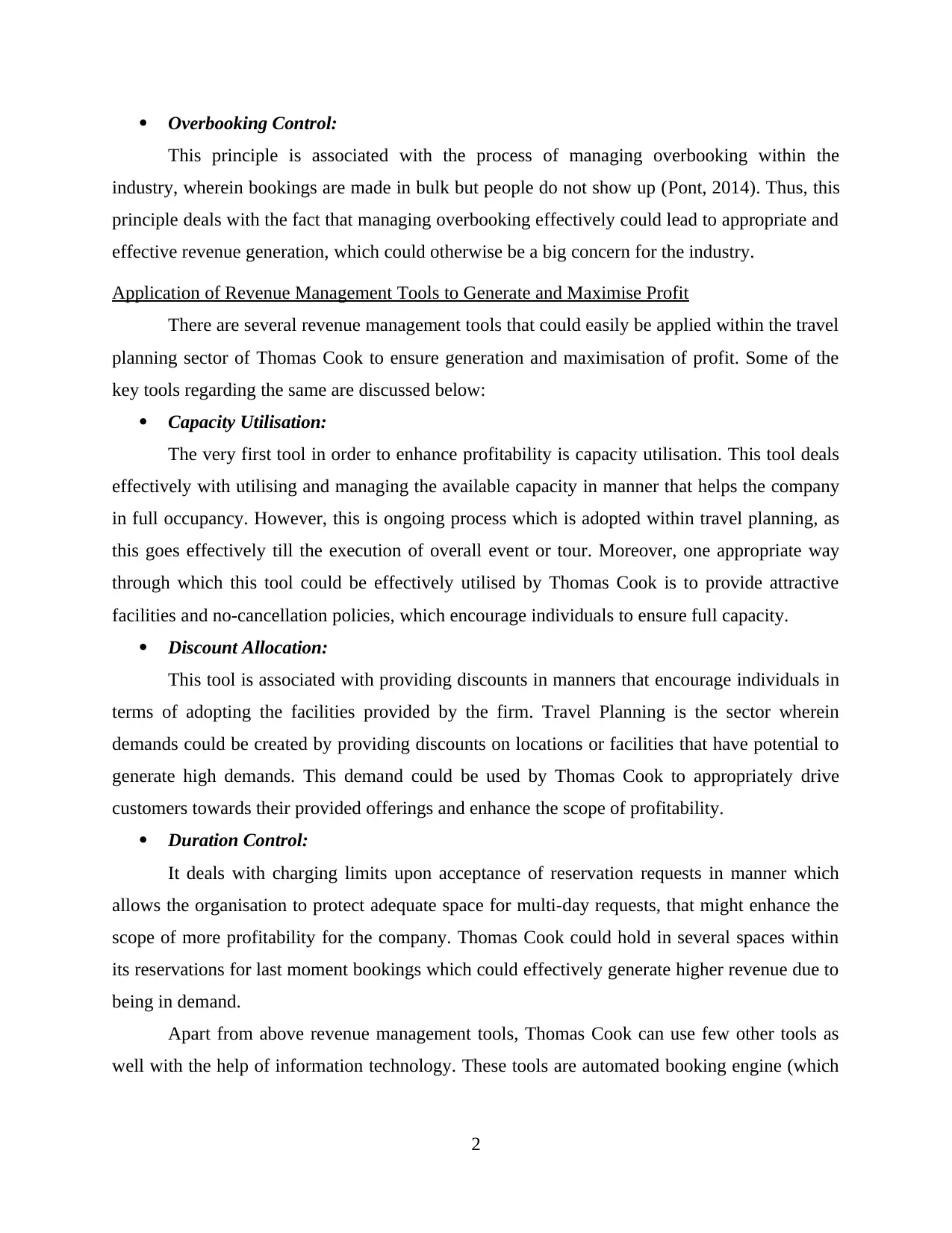
Overbooking Control:
This principle is associated with the process of managing overbooking within the
industry, wherein bookings are made in bulk but people do not show up (Pont, 2014). Thus, this
principle deals with the fact that managing overbooking effectively could lead to appropriate and
effective revenue generation, which could otherwise be a big concern for the industry.
Application of Revenue Management Tools to Generate and Maximise Profit
There are several revenue management tools that could easily be applied within the travel
planning sector of Thomas Cook to ensure generation and maximisation of profit. Some of the
key tools regarding the same are discussed below:
Capacity Utilisation:
The very first tool in order to enhance profitability is capacity utilisation. This tool deals
effectively with utilising and managing the available capacity in manner that helps the company
in full occupancy. However, this is ongoing process which is adopted within travel planning, as
this goes effectively till the execution of overall event or tour. Moreover, one appropriate way
through which this tool could be effectively utilised by Thomas Cook is to provide attractive
facilities and no-cancellation policies, which encourage individuals to ensure full capacity.
Discount Allocation:
This tool is associated with providing discounts in manners that encourage individuals in
terms of adopting the facilities provided by the firm. Travel Planning is the sector wherein
demands could be created by providing discounts on locations or facilities that have potential to
generate high demands. This demand could be used by Thomas Cook to appropriately drive
customers towards their provided offerings and enhance the scope of profitability.
Duration Control:
It deals with charging limits upon acceptance of reservation requests in manner which
allows the organisation to protect adequate space for multi-day requests, that might enhance the
scope of more profitability for the company. Thomas Cook could hold in several spaces within
its reservations for last moment bookings which could effectively generate higher revenue due to
being in demand.
Apart from above revenue management tools, Thomas Cook can use few other tools as
well with the help of information technology. These tools are automated booking engine (which
2
This principle is associated with the process of managing overbooking within the
industry, wherein bookings are made in bulk but people do not show up (Pont, 2014). Thus, this
principle deals with the fact that managing overbooking effectively could lead to appropriate and
effective revenue generation, which could otherwise be a big concern for the industry.
Application of Revenue Management Tools to Generate and Maximise Profit
There are several revenue management tools that could easily be applied within the travel
planning sector of Thomas Cook to ensure generation and maximisation of profit. Some of the
key tools regarding the same are discussed below:
Capacity Utilisation:
The very first tool in order to enhance profitability is capacity utilisation. This tool deals
effectively with utilising and managing the available capacity in manner that helps the company
in full occupancy. However, this is ongoing process which is adopted within travel planning, as
this goes effectively till the execution of overall event or tour. Moreover, one appropriate way
through which this tool could be effectively utilised by Thomas Cook is to provide attractive
facilities and no-cancellation policies, which encourage individuals to ensure full capacity.
Discount Allocation:
This tool is associated with providing discounts in manners that encourage individuals in
terms of adopting the facilities provided by the firm. Travel Planning is the sector wherein
demands could be created by providing discounts on locations or facilities that have potential to
generate high demands. This demand could be used by Thomas Cook to appropriately drive
customers towards their provided offerings and enhance the scope of profitability.
Duration Control:
It deals with charging limits upon acceptance of reservation requests in manner which
allows the organisation to protect adequate space for multi-day requests, that might enhance the
scope of more profitability for the company. Thomas Cook could hold in several spaces within
its reservations for last moment bookings which could effectively generate higher revenue due to
being in demand.
Apart from above revenue management tools, Thomas Cook can use few other tools as
well with the help of information technology. These tools are automated booking engine (which
2
Paraphrase This Document
Need a fresh take? Get an instant paraphrase of this document with our AI Paraphraser
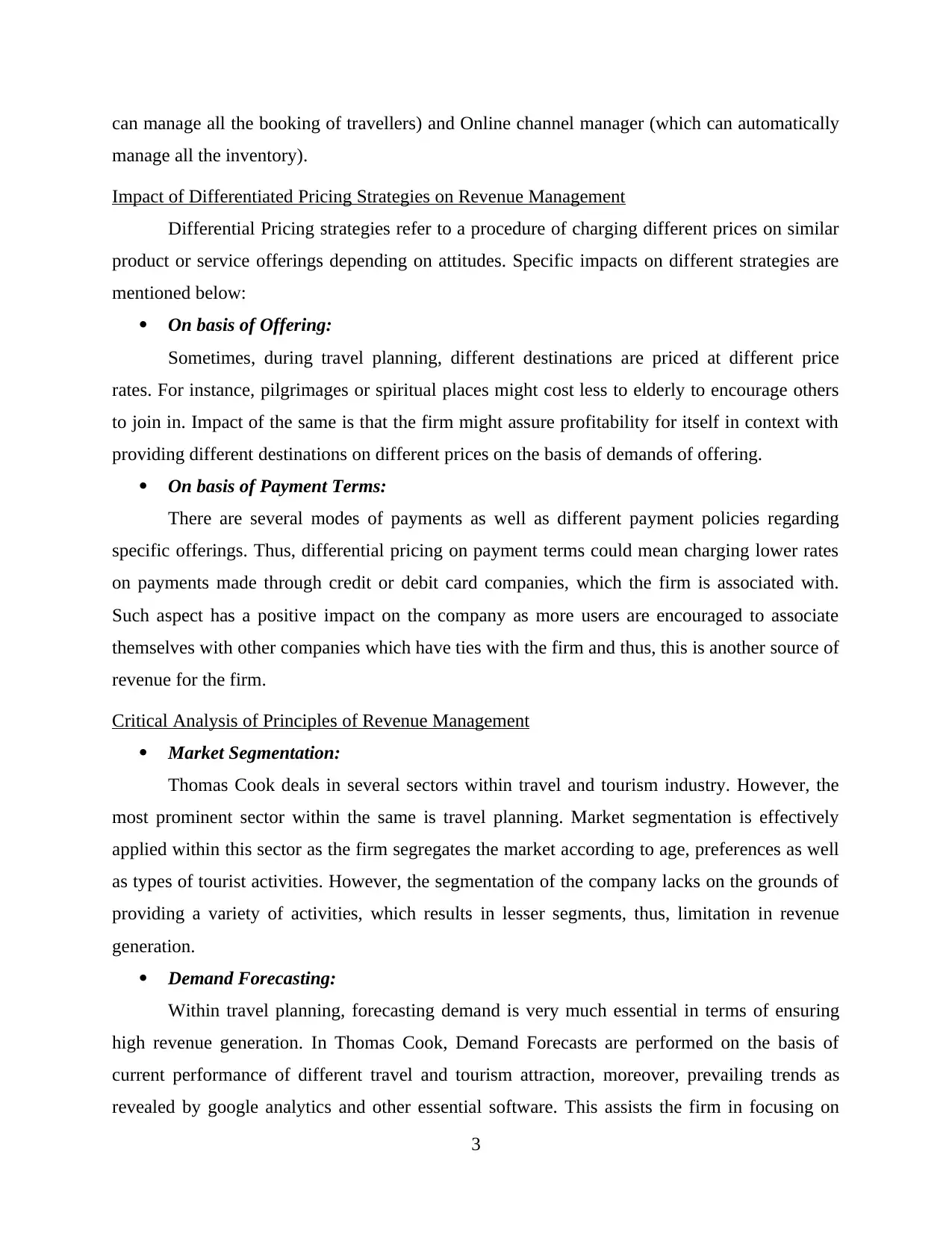
can manage all the booking of travellers) and Online channel manager (which can automatically
manage all the inventory).
Impact of Differentiated Pricing Strategies on Revenue Management
Differential Pricing strategies refer to a procedure of charging different prices on similar
product or service offerings depending on attitudes. Specific impacts on different strategies are
mentioned below:
On basis of Offering:
Sometimes, during travel planning, different destinations are priced at different price
rates. For instance, pilgrimages or spiritual places might cost less to elderly to encourage others
to join in. Impact of the same is that the firm might assure profitability for itself in context with
providing different destinations on different prices on the basis of demands of offering.
On basis of Payment Terms:
There are several modes of payments as well as different payment policies regarding
specific offerings. Thus, differential pricing on payment terms could mean charging lower rates
on payments made through credit or debit card companies, which the firm is associated with.
Such aspect has a positive impact on the company as more users are encouraged to associate
themselves with other companies which have ties with the firm and thus, this is another source of
revenue for the firm.
Critical Analysis of Principles of Revenue Management
Market Segmentation:
Thomas Cook deals in several sectors within travel and tourism industry. However, the
most prominent sector within the same is travel planning. Market segmentation is effectively
applied within this sector as the firm segregates the market according to age, preferences as well
as types of tourist activities. However, the segmentation of the company lacks on the grounds of
providing a variety of activities, which results in lesser segments, thus, limitation in revenue
generation.
Demand Forecasting:
Within travel planning, forecasting demand is very much essential in terms of ensuring
high revenue generation. In Thomas Cook, Demand Forecasts are performed on the basis of
current performance of different travel and tourism attraction, moreover, prevailing trends as
revealed by google analytics and other essential software. This assists the firm in focusing on
3
manage all the inventory).
Impact of Differentiated Pricing Strategies on Revenue Management
Differential Pricing strategies refer to a procedure of charging different prices on similar
product or service offerings depending on attitudes. Specific impacts on different strategies are
mentioned below:
On basis of Offering:
Sometimes, during travel planning, different destinations are priced at different price
rates. For instance, pilgrimages or spiritual places might cost less to elderly to encourage others
to join in. Impact of the same is that the firm might assure profitability for itself in context with
providing different destinations on different prices on the basis of demands of offering.
On basis of Payment Terms:
There are several modes of payments as well as different payment policies regarding
specific offerings. Thus, differential pricing on payment terms could mean charging lower rates
on payments made through credit or debit card companies, which the firm is associated with.
Such aspect has a positive impact on the company as more users are encouraged to associate
themselves with other companies which have ties with the firm and thus, this is another source of
revenue for the firm.
Critical Analysis of Principles of Revenue Management
Market Segmentation:
Thomas Cook deals in several sectors within travel and tourism industry. However, the
most prominent sector within the same is travel planning. Market segmentation is effectively
applied within this sector as the firm segregates the market according to age, preferences as well
as types of tourist activities. However, the segmentation of the company lacks on the grounds of
providing a variety of activities, which results in lesser segments, thus, limitation in revenue
generation.
Demand Forecasting:
Within travel planning, forecasting demand is very much essential in terms of ensuring
high revenue generation. In Thomas Cook, Demand Forecasts are performed on the basis of
current performance of different travel and tourism attraction, moreover, prevailing trends as
revealed by google analytics and other essential software. This assists the firm in focusing on
3
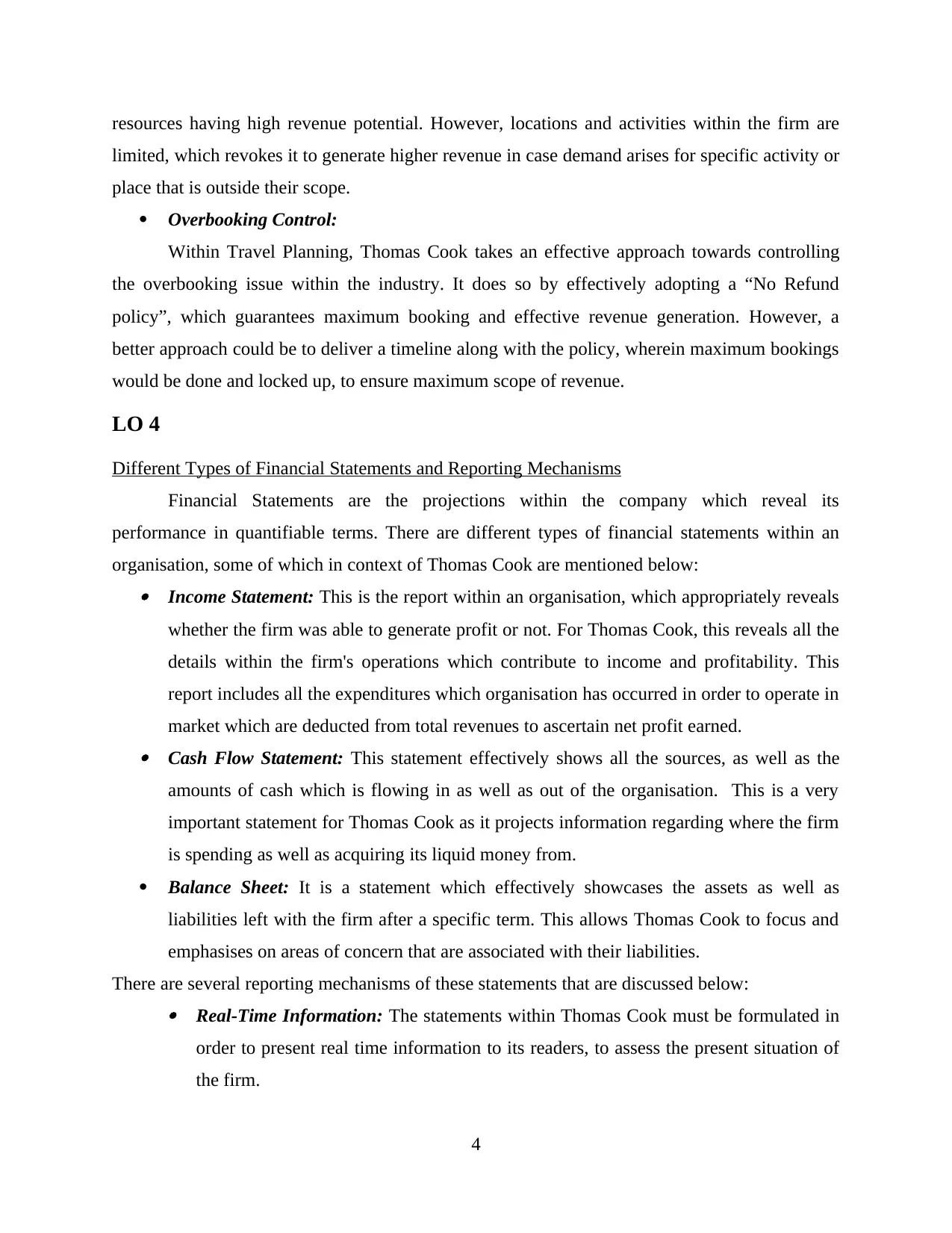
resources having high revenue potential. However, locations and activities within the firm are
limited, which revokes it to generate higher revenue in case demand arises for specific activity or
place that is outside their scope.
Overbooking Control:
Within Travel Planning, Thomas Cook takes an effective approach towards controlling
the overbooking issue within the industry. It does so by effectively adopting a “No Refund
policy”, which guarantees maximum booking and effective revenue generation. However, a
better approach could be to deliver a timeline along with the policy, wherein maximum bookings
would be done and locked up, to ensure maximum scope of revenue.
LO 4
Different Types of Financial Statements and Reporting Mechanisms
Financial Statements are the projections within the company which reveal its
performance in quantifiable terms. There are different types of financial statements within an
organisation, some of which in context of Thomas Cook are mentioned below: Income Statement: This is the report within an organisation, which appropriately reveals
whether the firm was able to generate profit or not. For Thomas Cook, this reveals all the
details within the firm's operations which contribute to income and profitability. This
report includes all the expenditures which organisation has occurred in order to operate in
market which are deducted from total revenues to ascertain net profit earned. Cash Flow Statement: This statement effectively shows all the sources, as well as the
amounts of cash which is flowing in as well as out of the organisation. This is a very
important statement for Thomas Cook as it projects information regarding where the firm
is spending as well as acquiring its liquid money from.
Balance Sheet: It is a statement which effectively showcases the assets as well as
liabilities left with the firm after a specific term. This allows Thomas Cook to focus and
emphasises on areas of concern that are associated with their liabilities.
There are several reporting mechanisms of these statements that are discussed below:
Real-Time Information: The statements within Thomas Cook must be formulated in
order to present real time information to its readers, to assess the present situation of
the firm.
4
limited, which revokes it to generate higher revenue in case demand arises for specific activity or
place that is outside their scope.
Overbooking Control:
Within Travel Planning, Thomas Cook takes an effective approach towards controlling
the overbooking issue within the industry. It does so by effectively adopting a “No Refund
policy”, which guarantees maximum booking and effective revenue generation. However, a
better approach could be to deliver a timeline along with the policy, wherein maximum bookings
would be done and locked up, to ensure maximum scope of revenue.
LO 4
Different Types of Financial Statements and Reporting Mechanisms
Financial Statements are the projections within the company which reveal its
performance in quantifiable terms. There are different types of financial statements within an
organisation, some of which in context of Thomas Cook are mentioned below: Income Statement: This is the report within an organisation, which appropriately reveals
whether the firm was able to generate profit or not. For Thomas Cook, this reveals all the
details within the firm's operations which contribute to income and profitability. This
report includes all the expenditures which organisation has occurred in order to operate in
market which are deducted from total revenues to ascertain net profit earned. Cash Flow Statement: This statement effectively shows all the sources, as well as the
amounts of cash which is flowing in as well as out of the organisation. This is a very
important statement for Thomas Cook as it projects information regarding where the firm
is spending as well as acquiring its liquid money from.
Balance Sheet: It is a statement which effectively showcases the assets as well as
liabilities left with the firm after a specific term. This allows Thomas Cook to focus and
emphasises on areas of concern that are associated with their liabilities.
There are several reporting mechanisms of these statements that are discussed below:
Real-Time Information: The statements within Thomas Cook must be formulated in
order to present real time information to its readers, to assess the present situation of
the firm.
4
⊘ This is a preview!⊘
Do you want full access?
Subscribe today to unlock all pages.

Trusted by 1+ million students worldwide
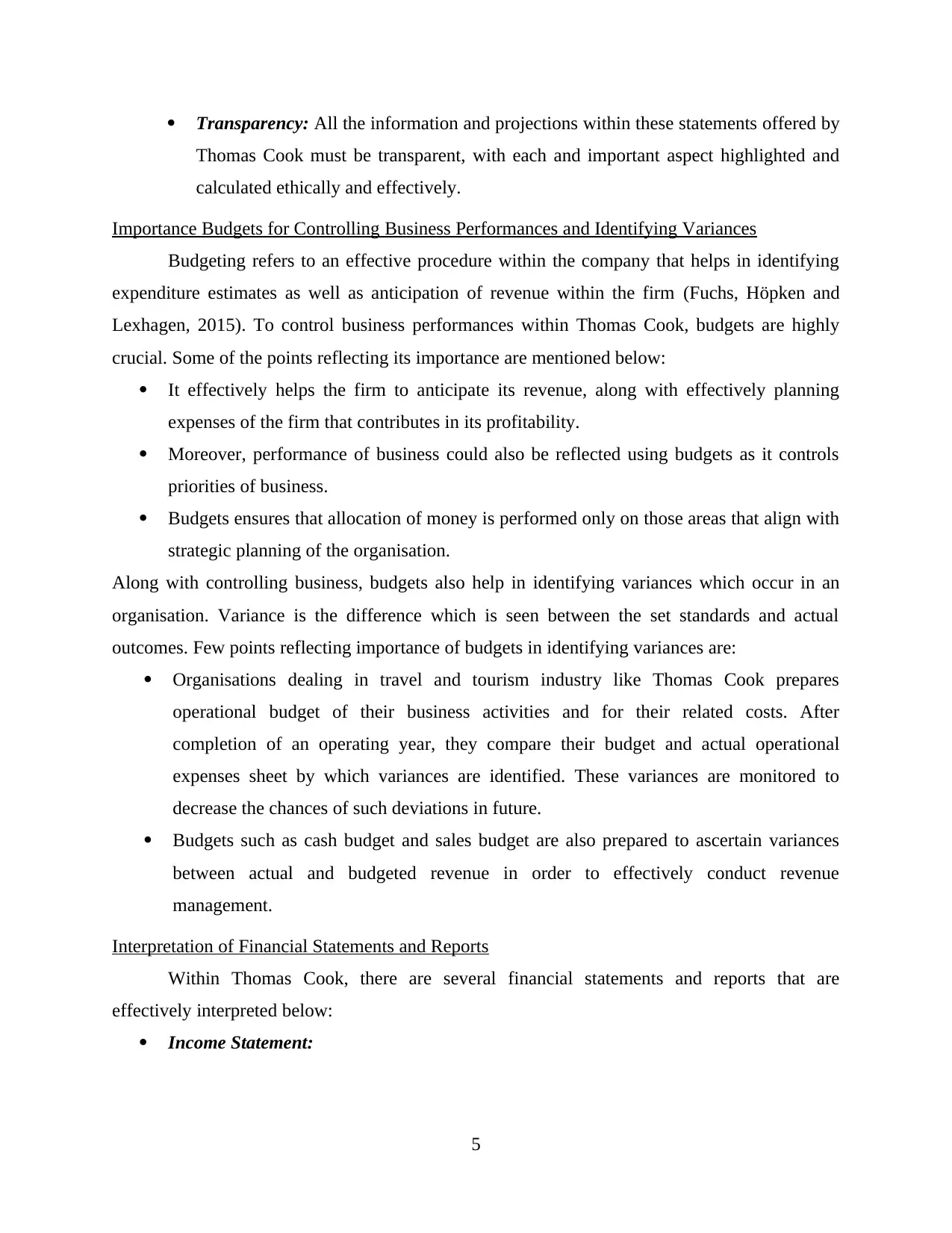
Transparency: All the information and projections within these statements offered by
Thomas Cook must be transparent, with each and important aspect highlighted and
calculated ethically and effectively.
Importance Budgets for Controlling Business Performances and Identifying Variances
Budgeting refers to an effective procedure within the company that helps in identifying
expenditure estimates as well as anticipation of revenue within the firm (Fuchs, Höpken and
Lexhagen, 2015). To control business performances within Thomas Cook, budgets are highly
crucial. Some of the points reflecting its importance are mentioned below:
It effectively helps the firm to anticipate its revenue, along with effectively planning
expenses of the firm that contributes in its profitability.
Moreover, performance of business could also be reflected using budgets as it controls
priorities of business.
Budgets ensures that allocation of money is performed only on those areas that align with
strategic planning of the organisation.
Along with controlling business, budgets also help in identifying variances which occur in an
organisation. Variance is the difference which is seen between the set standards and actual
outcomes. Few points reflecting importance of budgets in identifying variances are:
Organisations dealing in travel and tourism industry like Thomas Cook prepares
operational budget of their business activities and for their related costs. After
completion of an operating year, they compare their budget and actual operational
expenses sheet by which variances are identified. These variances are monitored to
decrease the chances of such deviations in future.
Budgets such as cash budget and sales budget are also prepared to ascertain variances
between actual and budgeted revenue in order to effectively conduct revenue
management.
Interpretation of Financial Statements and Reports
Within Thomas Cook, there are several financial statements and reports that are
effectively interpreted below:
Income Statement:
5
Thomas Cook must be transparent, with each and important aspect highlighted and
calculated ethically and effectively.
Importance Budgets for Controlling Business Performances and Identifying Variances
Budgeting refers to an effective procedure within the company that helps in identifying
expenditure estimates as well as anticipation of revenue within the firm (Fuchs, Höpken and
Lexhagen, 2015). To control business performances within Thomas Cook, budgets are highly
crucial. Some of the points reflecting its importance are mentioned below:
It effectively helps the firm to anticipate its revenue, along with effectively planning
expenses of the firm that contributes in its profitability.
Moreover, performance of business could also be reflected using budgets as it controls
priorities of business.
Budgets ensures that allocation of money is performed only on those areas that align with
strategic planning of the organisation.
Along with controlling business, budgets also help in identifying variances which occur in an
organisation. Variance is the difference which is seen between the set standards and actual
outcomes. Few points reflecting importance of budgets in identifying variances are:
Organisations dealing in travel and tourism industry like Thomas Cook prepares
operational budget of their business activities and for their related costs. After
completion of an operating year, they compare their budget and actual operational
expenses sheet by which variances are identified. These variances are monitored to
decrease the chances of such deviations in future.
Budgets such as cash budget and sales budget are also prepared to ascertain variances
between actual and budgeted revenue in order to effectively conduct revenue
management.
Interpretation of Financial Statements and Reports
Within Thomas Cook, there are several financial statements and reports that are
effectively interpreted below:
Income Statement:
5
Paraphrase This Document
Need a fresh take? Get an instant paraphrase of this document with our AI Paraphraser
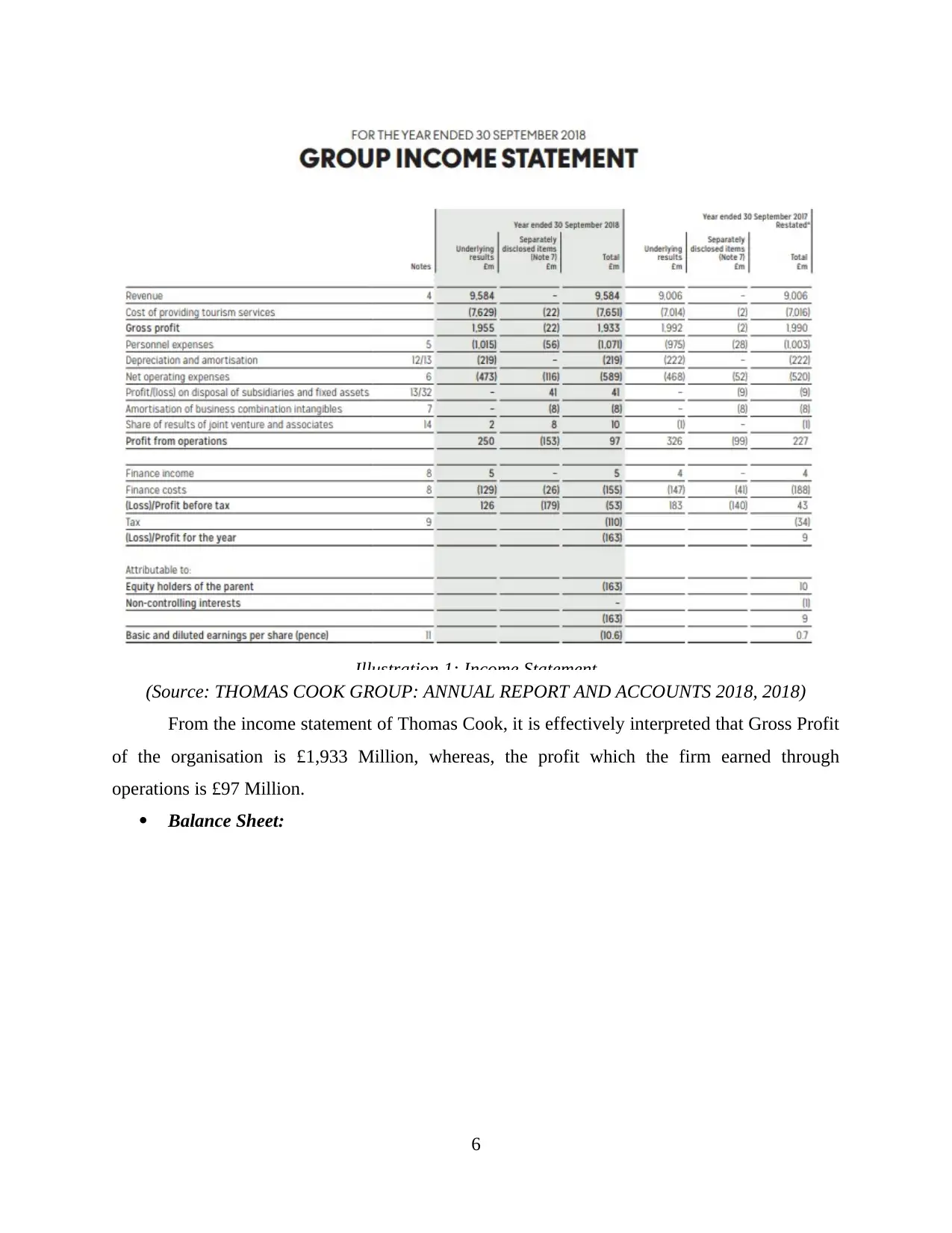
Illustration 1: Income Statement
(Source: THOMAS COOK GROUP: ANNUAL REPORT AND ACCOUNTS 2018, 2018)
From the income statement of Thomas Cook, it is effectively interpreted that Gross Profit
of the organisation is £1,933 Million, whereas, the profit which the firm earned through
operations is £97 Million.
Balance Sheet:
6
(Source: THOMAS COOK GROUP: ANNUAL REPORT AND ACCOUNTS 2018, 2018)
From the income statement of Thomas Cook, it is effectively interpreted that Gross Profit
of the organisation is £1,933 Million, whereas, the profit which the firm earned through
operations is £97 Million.
Balance Sheet:
6
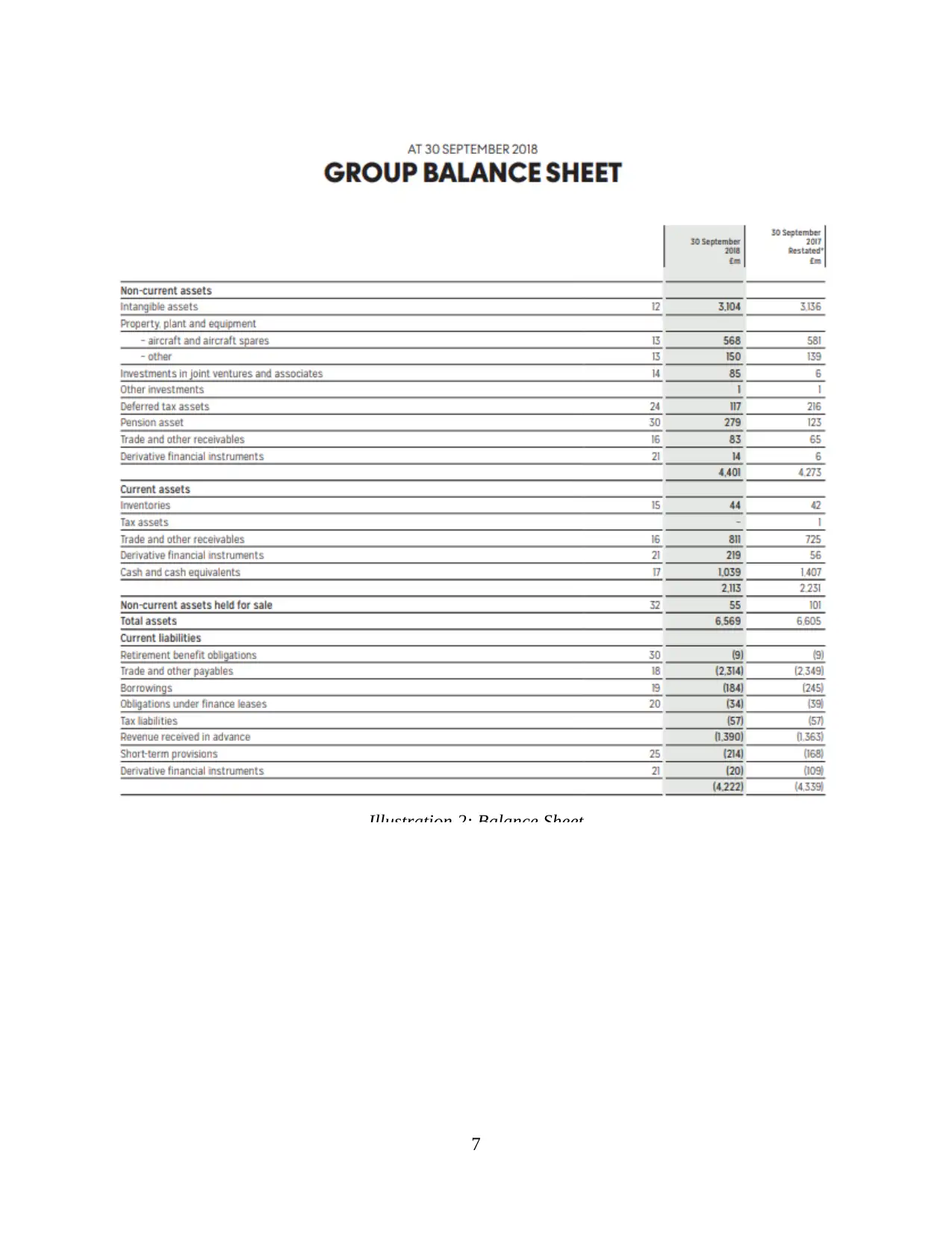
Illustration 2: Balance Sheet
7
7
⊘ This is a preview!⊘
Do you want full access?
Subscribe today to unlock all pages.

Trusted by 1+ million students worldwide
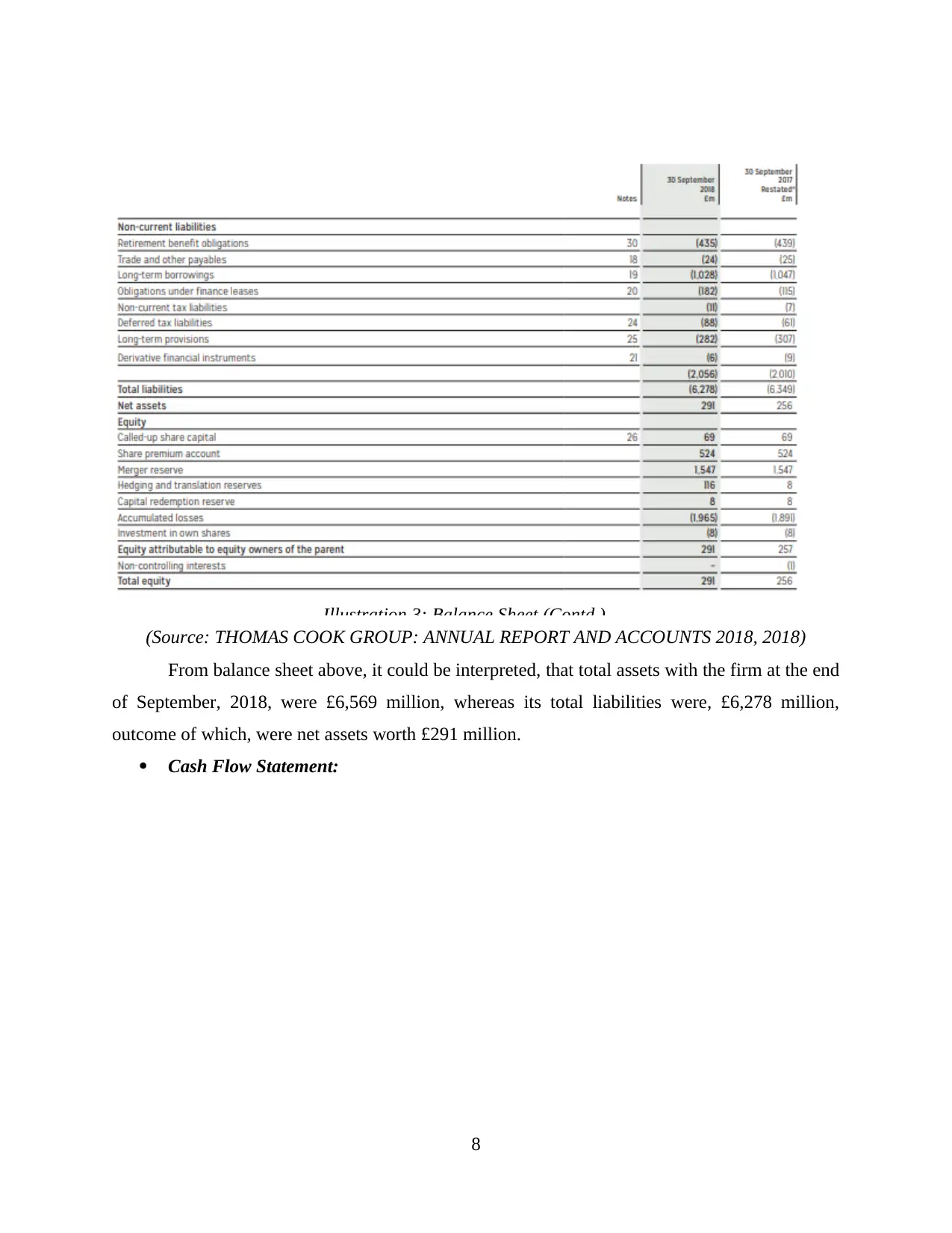
Illustration 3: Balance Sheet (Contd.)
(Source: THOMAS COOK GROUP: ANNUAL REPORT AND ACCOUNTS 2018, 2018)
From balance sheet above, it could be interpreted, that total assets with the firm at the end
of September, 2018, were £6,569 million, whereas its total liabilities were, £6,278 million,
outcome of which, were net assets worth £291 million.
Cash Flow Statement:
8
(Source: THOMAS COOK GROUP: ANNUAL REPORT AND ACCOUNTS 2018, 2018)
From balance sheet above, it could be interpreted, that total assets with the firm at the end
of September, 2018, were £6,569 million, whereas its total liabilities were, £6,278 million,
outcome of which, were net assets worth £291 million.
Cash Flow Statement:
8
Paraphrase This Document
Need a fresh take? Get an instant paraphrase of this document with our AI Paraphraser
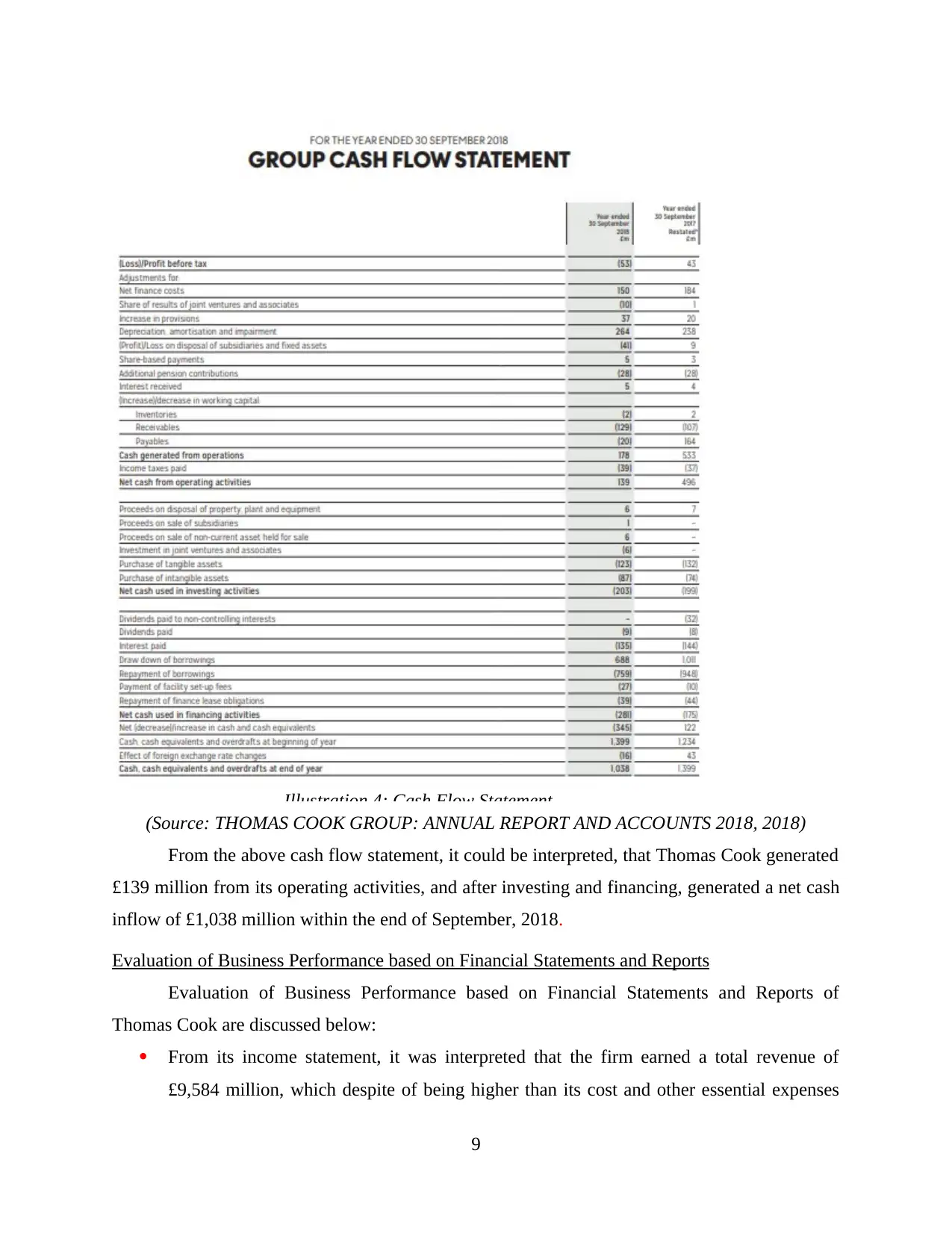
Illustration 4: Cash Flow Statement
(Source: THOMAS COOK GROUP: ANNUAL REPORT AND ACCOUNTS 2018, 2018)
From the above cash flow statement, it could be interpreted, that Thomas Cook generated
£139 million from its operating activities, and after investing and financing, generated a net cash
inflow of £1,038 million within the end of September, 2018.
Evaluation of Business Performance based on Financial Statements and Reports
Evaluation of Business Performance based on Financial Statements and Reports of
Thomas Cook are discussed below:
From its income statement, it was interpreted that the firm earned a total revenue of
£9,584 million, which despite of being higher than its cost and other essential expenses
9
(Source: THOMAS COOK GROUP: ANNUAL REPORT AND ACCOUNTS 2018, 2018)
From the above cash flow statement, it could be interpreted, that Thomas Cook generated
£139 million from its operating activities, and after investing and financing, generated a net cash
inflow of £1,038 million within the end of September, 2018.
Evaluation of Business Performance based on Financial Statements and Reports
Evaluation of Business Performance based on Financial Statements and Reports of
Thomas Cook are discussed below:
From its income statement, it was interpreted that the firm earned a total revenue of
£9,584 million, which despite of being higher than its cost and other essential expenses
9
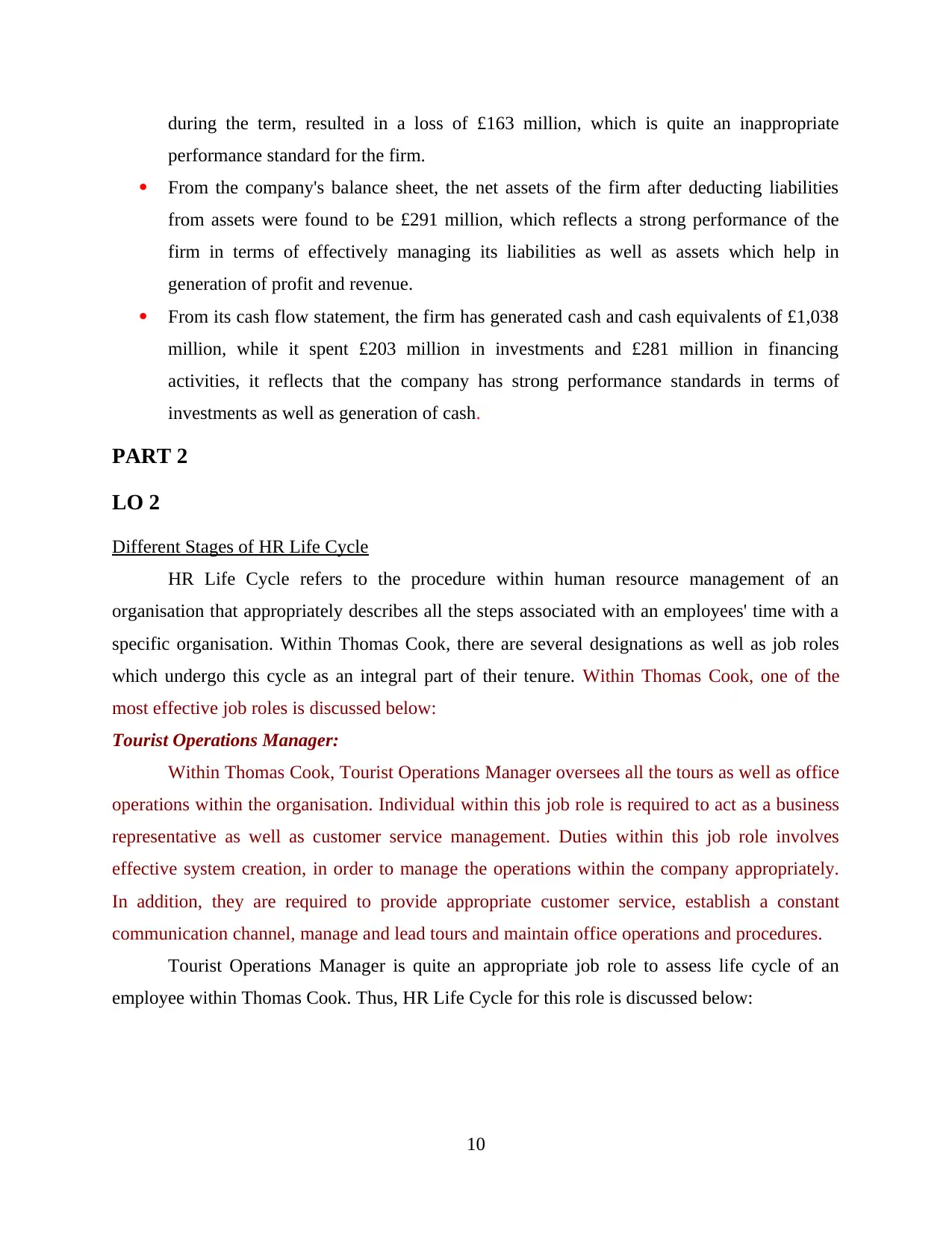
during the term, resulted in a loss of £163 million, which is quite an inappropriate
performance standard for the firm.
From the company's balance sheet, the net assets of the firm after deducting liabilities
from assets were found to be £291 million, which reflects a strong performance of the
firm in terms of effectively managing its liabilities as well as assets which help in
generation of profit and revenue.
From its cash flow statement, the firm has generated cash and cash equivalents of £1,038
million, while it spent £203 million in investments and £281 million in financing
activities, it reflects that the company has strong performance standards in terms of
investments as well as generation of cash.
PART 2
LO 2
Different Stages of HR Life Cycle
HR Life Cycle refers to the procedure within human resource management of an
organisation that appropriately describes all the steps associated with an employees' time with a
specific organisation. Within Thomas Cook, there are several designations as well as job roles
which undergo this cycle as an integral part of their tenure. Within Thomas Cook, one of the
most effective job roles is discussed below:
Tourist Operations Manager:
Within Thomas Cook, Tourist Operations Manager oversees all the tours as well as office
operations within the organisation. Individual within this job role is required to act as a business
representative as well as customer service management. Duties within this job role involves
effective system creation, in order to manage the operations within the company appropriately.
In addition, they are required to provide appropriate customer service, establish a constant
communication channel, manage and lead tours and maintain office operations and procedures.
Tourist Operations Manager is quite an appropriate job role to assess life cycle of an
employee within Thomas Cook. Thus, HR Life Cycle for this role is discussed below:
10
performance standard for the firm.
From the company's balance sheet, the net assets of the firm after deducting liabilities
from assets were found to be £291 million, which reflects a strong performance of the
firm in terms of effectively managing its liabilities as well as assets which help in
generation of profit and revenue.
From its cash flow statement, the firm has generated cash and cash equivalents of £1,038
million, while it spent £203 million in investments and £281 million in financing
activities, it reflects that the company has strong performance standards in terms of
investments as well as generation of cash.
PART 2
LO 2
Different Stages of HR Life Cycle
HR Life Cycle refers to the procedure within human resource management of an
organisation that appropriately describes all the steps associated with an employees' time with a
specific organisation. Within Thomas Cook, there are several designations as well as job roles
which undergo this cycle as an integral part of their tenure. Within Thomas Cook, one of the
most effective job roles is discussed below:
Tourist Operations Manager:
Within Thomas Cook, Tourist Operations Manager oversees all the tours as well as office
operations within the organisation. Individual within this job role is required to act as a business
representative as well as customer service management. Duties within this job role involves
effective system creation, in order to manage the operations within the company appropriately.
In addition, they are required to provide appropriate customer service, establish a constant
communication channel, manage and lead tours and maintain office operations and procedures.
Tourist Operations Manager is quite an appropriate job role to assess life cycle of an
employee within Thomas Cook. Thus, HR Life Cycle for this role is discussed below:
10
⊘ This is a preview!⊘
Do you want full access?
Subscribe today to unlock all pages.

Trusted by 1+ million students worldwide
1 out of 21
Related Documents
Your All-in-One AI-Powered Toolkit for Academic Success.
+13062052269
info@desklib.com
Available 24*7 on WhatsApp / Email
![[object Object]](/_next/static/media/star-bottom.7253800d.svg)
Unlock your academic potential
Copyright © 2020–2025 A2Z Services. All Rights Reserved. Developed and managed by ZUCOL.





